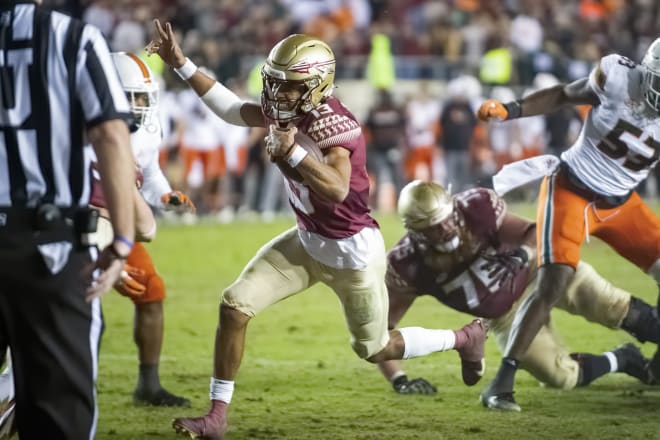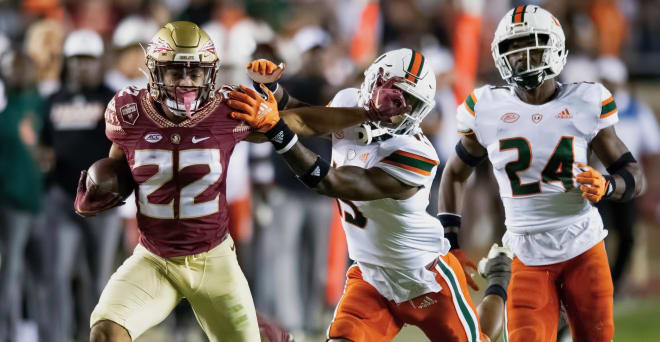FSU's ascent began with hard-fought 2021 win over Miami

The roots of Florida State’s success the last two seasons can be directly traced to a November night two years ago inside Doak Campbell Stadium.
FSU started the 2021 season 0-4, found some footing with wins over Syracuse, at North Carolina and UMass but then fell short against ranked teams in Clemson and NC State. A Seminoles roster that was the youngest in the Football Bowl Subdivision in 2020 was older with an infusion of transfers brought in by coach Mike Norvell and the staff but was still a toddler — graduating from crawling but often running a few steps forward and stumbling.
“Specifically for me on the offensive line and being on the offensive side of the ball, we were a young group,” offensive lineman Dillan Gibbons told the Osceola this week. “A group that some could say was kind of in shambles to that point. Was in the very beginning stages of what Coach Norvell developed at Florida State. A group that had confidence in each other, had confidence in individual abilities, but was yet to show that coming together, that accomplishing one goal on the football field in front of all of our fans.”
The Seminoles were just 6-12 under Norvell going into that game. They had beaten a ranked North Carolina in 2020 and knocked off the Tar Heels in 2021 on the road but had not defeated a major rival (Miami, Florida or Clemson) since a November 2017 victory at Florida. A long four years.
But the Seminoles grew up that night. After years of frustration, the work was validated with a 31-28 win over Miami on Nov. 13, 2021. A young team gained confidence in front of 71,917 fans at Doak Campbell Stadium.
“It helped a lot of guys,” FSU coach Mike Norvell said. “That was one of those emotional days. They got to be in it. They controlled it, they responded.”
FSU drove 78 yards on its first drive, culminating in Jordan Travis’ touchdown run. The Seminoles defense produced three takeaways on consecutive drives, a pair of interceptions and then a fumble. That third takeaway (a sack by Jermaine Johnson and fumble recovery by Derrick McLendon) set up FSU with the ball on the Miami 12, and Jashaun Corbin ran it in on the next play. A few minutes into the second quarter, Ryan Fitzgerald hit a 22-yard field-goal attempt and the Seminoles looked to be pulling away 17-0.

But Miami struck back as Tyler Van Dyke tossed four touchdown passes — one each in the second and third quarters but then two more in the fourth. FSU’s defense had held Miami to 39 offensive yards and no points before the Hurricanes scored on four of five drives to jump in front 28-20 with 11:04 to go.
“I thought our guys maintained their control and composure throughout it,” Norvell said. “They were able to execute even through the swings of it. We were up early. Found ourselves down late.”
Trailing but with time, the Seminoles drove the field in six minutes but settled for another Fitzgerald field-goal attempt. After a Miami punt, FSU had the ball with 2:19 to go.
Travis connected with Ja’Khi Douglas, who was lined up in the slot, but got some separation and hauled in a perfectly-thrown pass that hit him in stride and the receiver ran down to the Miami 20 on a 59-yard reception. But a 1-yard run, a pre-snap penalty and two incompletions later, and the Seminoles faced fourth-and-14.
Miami rushed three and dropped eight, forcing Travis to find a window. He did, connecting with Andrew Parchment over the middle for more than a first down as Parchment ran and was tackled at the Miami 1.
First down, Travis run, no gain.
Second down, Travis run, no gain.
But Miami was offsides.
Second down, Travis runs left behind Gibbons, the left guard, and left tackle Robert Scott. Touchdown, FSU.
“As I finished my guy into the end zone, I rolled and basically had Jordan Travis in my lap in the end zone and that was a special moment for me,” Gibbons said. “When I look back, that's one of the games I remember as a pivotal turning point where we figured out we could win those games we could push in the last few minutes.”
Gibbons recalled the cleat marks in the grass at Doak, apparent for weeks, perhaps not truly an indelible impression but one that were footsteps on the Seminoles’ climb.

Travis was 7 of 12 for 112 yards in the fourth quarter, including the two big pass plays on the final drive. He also had 22 carries for 62 yards on the night.
“Just being a kid that didn’t believe in himself too much and going out there in a game like that and beating Miami in the way we did, obviously boosts your confidence a lot,” Travis said. “It did change my life a lot.”
It likely changed the lives of many of the Seminoles players. Helped by a number of transfers, FSU had a rivalry win. Johnson had three sacks. Fabien Lovett had three tackles. Jashaun Corbin had 68 yards and a touchdown. Parchment had struggled for much of the year but had an unforgettable catch. Gibbons helped take the linemen under his wing.
But FSU’s 31-28 win over Miami was a critical developmental moment for younger players who made an impact, including the likes of Kalen DeLoach, Akeem Dent, Malcolm Ray, DJ Lundy and Renardo Green on defense to Douglas, Kentron Poitier and Darion Williamson on offense.
“To have to show all the preparation, to show all the investment of the work for the payoff of how that game played out just as much as the game in general, it was really big,” Norvell said.
Including that 2021 win over Miami, the Seminoles are 21-4 since then as they prepare for another rivalry game with the Hurricanes on Saturday.
Gibbons said what he enjoyed was offensive line coach Alex Atkins’ philosophy of watching a game backwards. The FSU offense’s last play technically was a two-point conversion, but there were so many well-executed plays as part of the final drive — one that also showed the players’ toughness mentally and physically — that resulted in the Seminoles’ win.
“We were judged off our effort, performance, finish, technique and fundamentals at that last play if not harder than the first play of the game,” Gibbons said. “And that's the difference between a good football team and a championship-level football team.”
Follow The Osceola on Facebook
Follow The Osceola on Twitter
Subscribe to the Osceola's YouTube channel
Subscribe to the Osceola's podcasts on Apple
Subscribe to the Osceola's podcasts on Spotify
